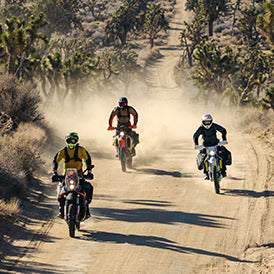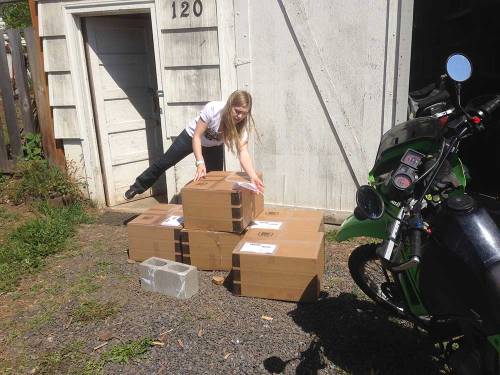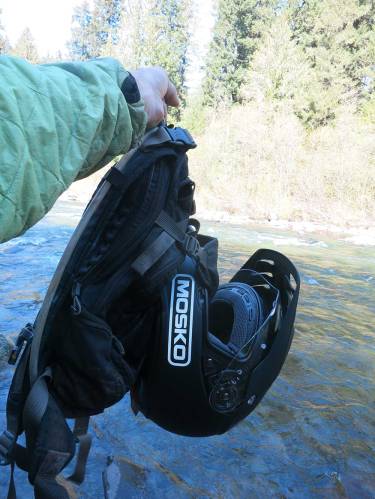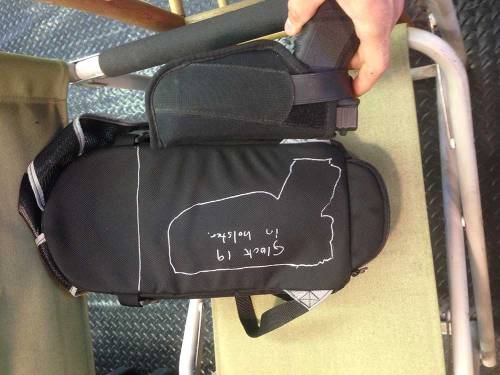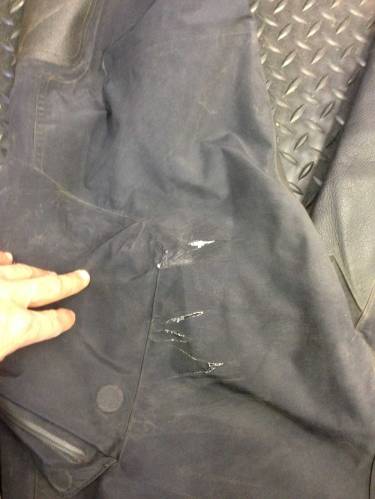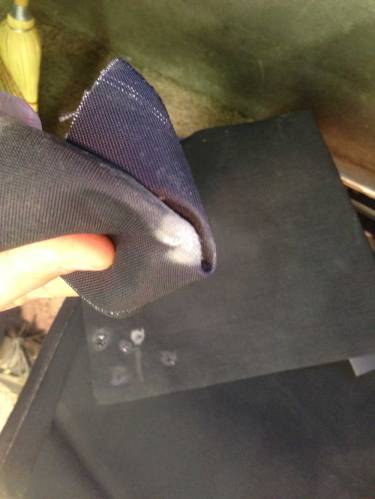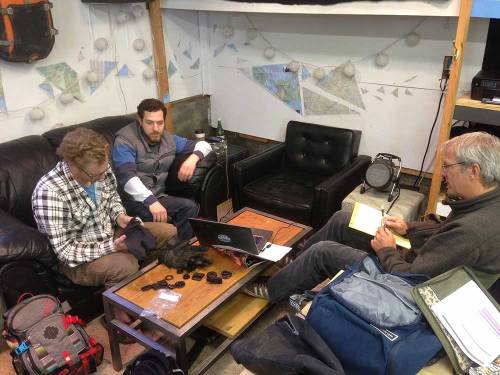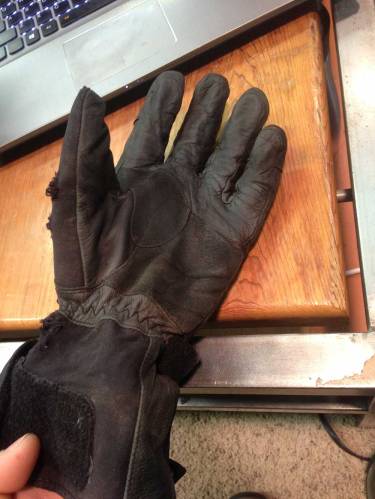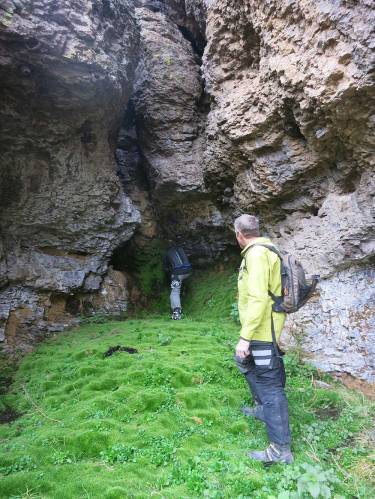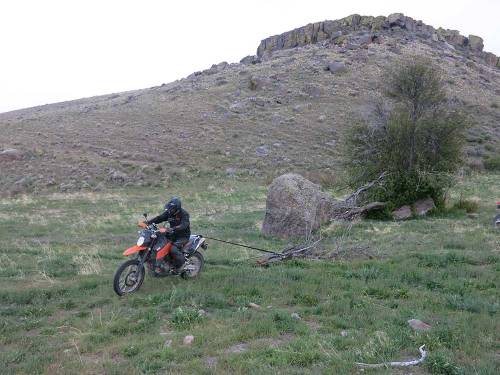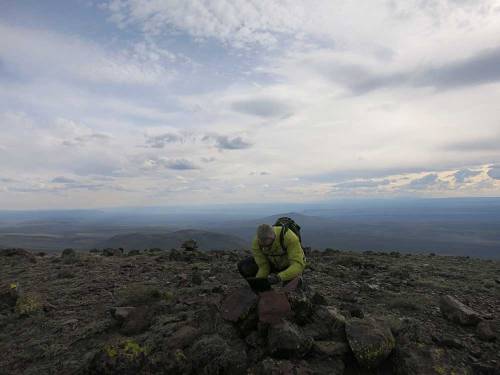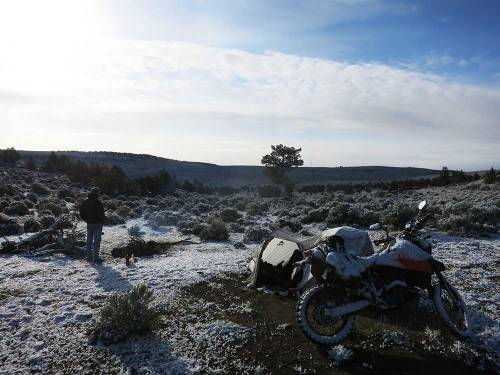Your Cart is Empty
Luggage
Apparel
Events
The Mosko Blog
More Reckless Crash Testing
May 02, 2015
More Reckless Crash Testing
May 1, 2015
Not that we needed to do anymore crash testing on this bag, but a few weeks ago I took off for a couple nights solo camping in the cascades with the Reckless 80 and some of our new camping gear. Awesome trip. All the features of the Reckless bags have been covered already in past reports, but one new thing from this trip is that I went for a pavement slide on a forest service road at maybe 35-40 mph. I veered into some slippery moss and don’t really remember going down, just sliding on my side for 30 feet or so. In the pic below, I ended up on the opposite side of the road from the bike. Real-world pavement sliding is probably the best possible abrasion test for soft goods.
It was interesting to look at the abrasion scars on the bag after the slide. Bottom line, the outer bag absolutely did its job, protecting the inner drybag from any kind of abrasion. The inner drybag never made any kind of contact with the pavement. In other words, even after the slide, all my stuff was still 100% waterproof. Was so stoked about that. The crash did nothing to affect the functionality of the bag at all, and the outer abrasion holes can be patched. With a loaded 950 twin sliding on pavement, I couldn’t ask for a better outcome.

Man the hypalon patch held up really well. The 1680D ballistic nylon did its job but wore through a little on a spot at the bottom of the bag and also on the rear pocket. The hole on the rear pocket was from the dromedary bag nozzle. The nozzle ground the ballistic between the plastic and the pavement. It’s actually kind of cool to have that hole where the nozzle can poke out now. Looking at the hole when I got back, Andrew and I decided to add a hydration nozzle opening there on the next design revision. We’re also talking about possibly extending the hypalon patch to the underside of the bag and around back on the rear pocket, since it held up so well.
Here’s what the dromedary nozzle looked like. It leaked after this but I had some aquaseal which fixed that up.
I’ve been riding with less water lately, and this made me think about water filters again, because I hate running low on water. After the accident down in Honduras a couple years ago I’m really sensitive to the possibility of a crash or injury happening somewhere remote while solo and not having enough water to get out or wait for help. Normally I carry 3L in my pack and 4L split up over two 2L bags in my side bags for a total of 7L, which is enough to get through one comfortable day/night with drinking/cooking/cleaning and still have a little extra in case I’m unexpectedly out for 2 nights without refilling. But water is heavy and takes up a lot of space, so on the trip above and also in the desert trip last week I reduced it to 5L. Both times I ran low on water, above because of the crash and in the desert because it’s the desert. Now I’m carrying a filter (more on that below).
BMW Adapters
The first production batch of BMW adapters are moving through production. We picked them up from the laser cutters and peeled off the protective film.
From there they went to a local welder in Hood River.
The adapters are made from stainless, so we weren’t originally planning to coat/finish them, but now they have these ugly weld marks so we’ll need to do a finish.

Lee is taking over the adapter project. He did some research and decided black powder coat was the most economical and realistic finishing solution. The adapters will be stainless with powder coat. At least you don’t have to worry about rust ha! We have all the hardware bits and pieces, so Lee will be putting these together with some instruction sheets over the next few weeks, and then finally we’ll put them up on the website. They turned out to be more expensive than expected. The initial price is going to be $125 for the 1200GS/A and $175 for the F800GSA (which has two adapters, one for both sides). Believe it or not that barely covers our cost in this first run. We’ll try to get the cost down in future iterations. At least we have a solution for now.
Lee’s first day, first project: finish the BMW adapters.
Backcountry 35 Panniers Back In Stock!
We’ve been saying “April” as the restock date for the Backcountry 35L panniers. As it turns out, our actual production run could not be scheduled until the week of May 4, however to meet the April commitment we went into Portland and picked up a bunch of bags to bring back to White Salmon and assemble here ourselves. We managed to get most – but not quite all, we ran out of wedges – of the backorders out the door. Everything else will ship next week. Backcountry 35 panniers are now officially “back in stock!”
A little inventory makes the shop seem really small.
Nicole got a lesson on Backcountry 35 assembly and so did Lee. Lee will be overseeing the production run in Portland next week. Andrew came up with some process improvements and new hardware that really speeds up assembly.
Orders from the assembly run got boxed up immediately.
And shipped out to customers.
New Bag Designs
As mentioned in a prior post, the new tank bag is going to have a beavertail design that also works as a helmet carrier. If you’re wondering when/why that might come in handy, here’s a perfect example. Two weeks ago I was camped about 5 miles from a hot spring. The hot spring was about a 1.5 mile hike in from the road. I’m not leaving my expensive helmet sitting on the bike, but hiking with it in my hands sucks too. Solution: the beavertail helmet carrier.
Andrew has been cranking on the tank bag design and getting it ready for the next round of prototyping. We got a lot of requests for a handgun pocket (which can also be used for other things) so we got our hands on a Glock 19 and made sure it would fit. Guns are big, bulky things. I can see why someone would want a special pocket for it. It sort of takes up the entire tank bag if you put it in the main compartment, plus it would get jostled around all over the place. Same thing is true of a camera, so this pocket should work for either. We experimented using the pocket with the gun both in and out of the holster. Neither of us knows much about guns but hopefully this will work.
Andrew has also been working on the new hanging tool bag, which is nearly ready for prototyping.
Fabric Selection
I’ve ridden on two trips with our apparel so far. There are a bunch of things I liked and some other stuff I didn’t like, which we’re fixing. The current prototype is made from substitute fabric – not the fabric we actually plan to use – however it is not exactly lightweight fabric either. It’s some kind of waterproof/breathable fabric the factory had laying around, so presumably something from another moto manufacturer’s apparel line. One thing I was really struck by after only two trips is how many HOLES are in it. Here’s a quick inventory:
Right Sleeve abrasion
Right back side
Left arm, this was from a barbed wire fence.
Left sleeve abrasion
Right leg muffler burn
Butt abrasion scars
This just highlights how important it is to find the right fabric. And also how important it is to have a two-layer waterproofing system on a riding kit, because once you go for any kind of slide (dirt, rock, pavement, doesn’t matter), there is a risk that the outer layer waterproofing is going to be compromised. That’s why the BMW Rallye jackets have their waterproofing on the inside instead of on the outside. To make both layers out of a waterproof/breathable fabric would be too expensive, so they do an outer of a cordura-style fabric and an inner WP/BR, which also kind of sucks because the outer jacket gets soaked. I don’t know of any manufacturer currently doing BOTH a WP/BR outer layer AND an separate WP/BR inner layer. It would be too expensive,and probably doesn’t really seem to make sense at first glance. That’s one of the cool things we can do with our apparel, use the “direct sales” cost advantage to double-up on waterproofing. Even if you tear the outer jacket in a slide, you’ll still stay dry.
After the above observations, we also added Superfabric butt and hip panels in our pant design. We’ll test those out in the next round of samples.
Our search for the perfect outer-layer WP/BR fabric continues. We have a favorite now, a new fabric made by Toray. It’s literally brand new. And it held up to my in-shop abrasion test really well, better even than the Schoeller fabric we were looking at a few months ago.
This is how we test it. Put it over the finger and rub hard and fast on concrete until you can feel the concrete burning your finger. There’re really a huge difference between the fabrics we’ve tested like this so far.
Here’s the original Toray Kevlar fabric (at 12:00 in the pic below), the new Toray fabric (st 3:00), and the Schoeller fabric which we had the waterproofing issues with (at 6:00). The new Toray is not as aesthetically appealing as the other two but it held up better than either. They are making a 3-layer version of this for us to use in our next round of samples.
The new fabric after several passes on concrete. Still in tact. Awesome.
Mosko Gloves?
We had a meeting with Erik Hauge, who started DaKine’s glove program, which is now a major part of their business. He has also designed moto and snowmobile gloves in the past. Erik really knows the glove business. He has a contract development business now, and we discussed the possibility of a Mosko dualsport glove system for 2017.
We looked at my personal riding gloves, a combination of BMW, Klim, and Aerostitch. I am not a big fan of hard armor on gloves.
My new Aerostitch lobster mits. I really like the concept of these things but man they are so clumsy when riding. Last weekend it was snowing and we were coming through a rocky canyon up on the pegs and these things were driving me nuts. The fingertips kept catching on my levers, and even though my fingers technically move in pairs, I still found the lobster claws annoying. However my hands did stay dry. The trouble is that seam sealing machines can’t navigate the tight radius of a fingertip, hence the claw instead of a 5-fingered glove.
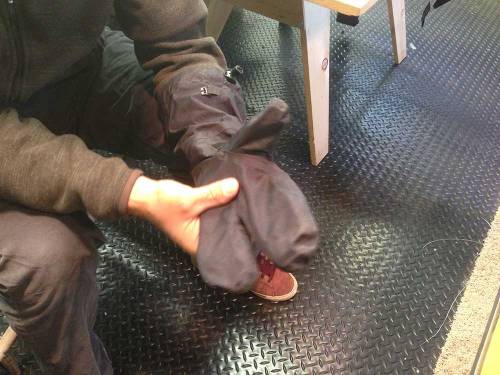
Maybe there’s an opportunity to do something here. Especially with Erik’s help. It’s on the radar.
MSR Tents
The new MSR Hubba one person tent with Gear shed is an absolutely killer piece of kit for the kind of riding I do. Which is why we’re stocking it on our website now. I’ve used it on three trips so far in rain, snow, and sun and I am telling you, it is awesome. We really don’t make much money by selling this stuff, we just like using it.
I mentioned earlier the water dilemma. Last week we had the chance to go out in the eastern Oregon desert with Dave Wachs (co-founder of Giant Loop and designer of the Altrider Hemispheres bag), who took us into some really cool new areas. Dave knows that terrain so well, and he travels really light, packing a gravity-feed water filter and stopping at springs to refill as he goes. I’ve been thinking about packing a water filter myself and this, plus the water shortages mentioned above, put me over the edge. I got one of the new Autoflow filters for myself and also ordered some extras to sell on our website.
Eastern Oregon Trip
And speaking of that trip, man was that ever fun. Dave, thanks so much for taking us out there and showing us around. Everyone had an awesome time and I can’t wait to get back down there. Climbing mountains, chasing springs, hunting arrowheads, drinking whiskey, and talking shit around the fire with my buddies. Too good. Check out Dave’s ride report HERE.
Warranty and Crash Replacement
We never cut corners during development or manufacturing, so we stand behind our products. If one fails due to a problem with materials or workmanship, we’ll make it right.
Your are successfully subscribed for email notifications.
Notify me when available
We will send you a notification as soon as this product is available again.
Your email is required
We don't share your email with anybody
x





